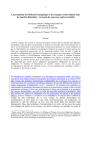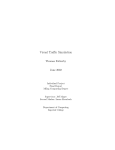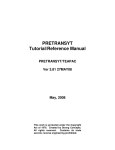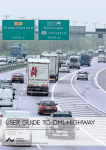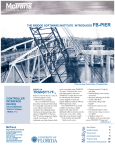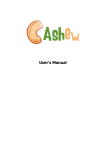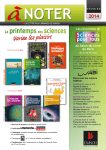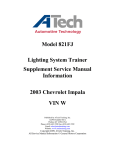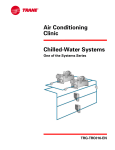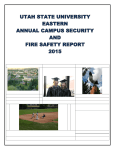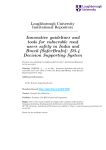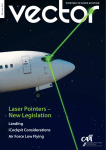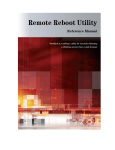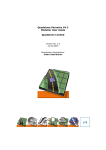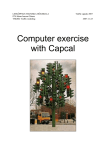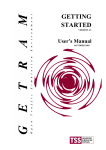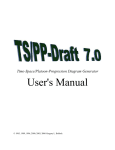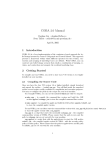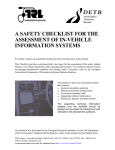Download June 2001
Transcript
Traffic Software News Quarterly Issue No. 18. June 2001 TRL Limited WEB - Serving you better! Website relaunched - www.trlsoftware.co.uk! As part of our ongoing commitment to customer service, the TRL Software Bureau has recently launched a new Web site. Our aim was to produce a much improved site, with greater ease of navigation and simple to use. Comments so far have been favourable, but we are always looking to improve. The site will be updated regularly with the latest news from the Software Bureau and any current special offers. New pages include a Forum for open discussion between users and a TRANSYT 11 demo download. Ordering TRL software is now only a click away. We would be grateful for any comments, so that this resource will be in tune with customer needs. An additional page has already been added in response to a customer request for a brief description of all products - an 'at a glance' one line summary. The site still has an exclusive section for our current maintenance users, with more 'hands on' information. If you have any TRL products with current maintenance please contact the Bureau for a Username and Password - then the latest information will always be at hand. We hope you will take time to visit our site and tell us what you think. TRL at TRAFFEX 2001 TRANSYT 11.1 The latest version of TRANSYT was released on 26 th March. This new version has been supplied to all current users of TRANSYT 11. It has a number of improvements compared with the last release. l l l l l improved usability: new button-bar and minor revisions to data entry screens. runs multiple files in ‘batch mode’ tested to run on Windows 95/ 98/ ME/ NT v4/ 2000 further integration with the ‘feature-rich’ Version 2 of the VIEWER program. various bug fixes, e.g. problems with modelling extremely large networks are now resolved. (Full details in the README file supplied with product) Software Bureau N.B. Demo version now available for download from www.trlsoftware.co.uk/download.htm The TRL Stand prior to opening The Software Bureau would like to thank all of you who visited the TRL stand at TRAFFEX. It was nice to see so many familiar faces, and to be able to put faces to familiar names! The software product demonstrations this year, SafeNet and MAAP, generated significant interest. As did the take-home TRL software demonstration CDs, and the booklets on offer. We hope that any enquiries you had were answered to satisfaction, and those that requested further information have now received it. If you should require further software information please do not hesitate to call the Software Bureau. TRAFFIC CONTROL TRULY INTERNATIONAL! Copy Protection As a corporate member of FAST (Federation Against Software Theft) TRL is committed to reducing software theft wherever possible. As part of this commitment we are introducing copyprotection to some of our software packages. This will help us to ensure that revenues due to us, are collected and directed back into new and improved products. We have worked hard to ensure that our new software registration process is as quick and easy as possible. Even more, Good News! On a recent vacation in Europe, I noted that the installation and the use of traffic signals varies considerably between countries. Whilst many of the towns and cities in Europe have wider streets than those in the UK it should still be possible to consider the techniques used elsewhere with the view of adopting the ‘best value’. At traffic signals in the UK, vehicle symbols and direction arrows are not permitted in the red aspect. The word ‘STOP’ was phased out some years ago and has not been replaced by any other alphanumeric characters. In contrast, direction arrows, cycle legends and the worded instructions are frequently used on the continent and, possibly, in other parts of the world. Their use is not permitted within the UK because it could be argued that they compromise safety in that the red aspect may not be so visible. However, I do not know of any accident statistics to suggest whether these items are any more or less dangerous. The same argument could also be given to the use of amber cycle aspects, which are permitted in the UK, and amber direction arrows that are not (yet) permitted in the UK. The photograph above shows a set of signals mounted on a catinary in Budapest. The photograph has not been edited and it is possible to make out the arrow in the red aspect. Whilst in Hungary I noted that secondary signals and stop lines are not always used. It is considered that not installing these features is likely to cause enforcement problems and increase the amount of litigation. However, it is interesting to note that all of the observed vehicles did stop in such a position so that the driver was still able to see the signals. In an attempt to give priority to specific vehicles I have also seen the word ‘BUS’ printed on the green lens in a set of signals. These appear to work satisfactorily although the message may not be so clear if viewed from a distance or during wet weather. In some countries, vehicles are allowed to turn on a conflicting green pedestrian aspect on the understanding that the pedestrian has the right of way. Despite the obvious increased risk of injury, this technique is common in Europe. In some countries a small set of signals are mounted on the primary pole at eye level. It is also common for the starting amber to be omitted and at night for the traffic lights to automatically switch to a flashing amber mode. However, I am uncertain as to what happens to the pedestrian facilities at these junctions. I do not support all the traffic engineering principles that I have mentioned above. I happen to believe that the UK has some of the best signing and pedestrian crossing facilities in Europe. Nevertheless, as the demand for road space increases shouldn’t we at least consider a more radical approach to traffic engineering? Perhaps we could learn a few things from our overseas neighbours. Robin Hutchinson, email: [email protected] As we introduce this change, product by product, we are also merging our UK (drive-on-the-left) and INTERNATIONAL (driveon-the-right) versions of ARCADY , PICADY and OSCADY. The products will be able to model both drive-on-the-right and driveon-the-left situations.* In effect, the previous UK and INTERNATIONAL versions will be replaced with truly INTERNATIONAL versions for the first time! The programs will let you switch from “drive-on-the-left” to “driveon-the-right” either by opening an existing data file (the program will switch automatically to the correct orientation for that file), or setting the orientation manually from “Main Menu/Options/ User Options”. A context-sensitive help system will be provided for both orientations and the correct one selected by the program automatically. *Use of these products is still subject to specific licence conditions for each registered site. Jim Binning Email: [email protected] QUARRY HAZARD INDEX SOFTWARE (QHIS) TRL has released Version 1.0 of its hazard score system for the assessment of the stability of rock slopes in quarries, enabling an improved, proactive approach to quarry rock slope risk assessment and management. The QHIS system enables slope classification based on standardised, rapid field data collection input and subsequent parametric analyses. Based on the hazard index, slopes are classified in terms of required action, enabling the prioritisation of funds. The program is based on MS ACCESS 97® application for Windows®.. Contact: Software Bureau FAQ Welcome again to FAQ. Here are some more ‘Frequently Asked Questions’ which you may find useful. NOTE: If you wish to discuss on-line any particular issues regarding our software products with other users and with ourselves at TRL we now have a ‘Forum’ section set up within the members section of our TRL Software Web Site. Is there a quick and easy way to find my way around the main help file? I often need to remind myself of how to measure, say, the geometric parameters required by ARCADY and PICADY. Yes there is; by pressing the F1 key the program will go straight to the most appropriate part of the help file. If you need to search further there are many hyperlinks, ones which are in the main body of the text (references in the hard-copy) and others which appear at the bottom of many of the topics which go to any sub-sections which may exist. In the example you give, you can press F1 from the Geometric Data entry form which will take you to the Data Input Chapter of the help file. From there, a hyperlink at the bottom of the page takes you to Appendix B which has details on how to measure the geometric parameters. Alternatively, the “Search for help on...” option on the “Help” menu may prove just as effective. FAQ continued........... it is variable then to be on the safe side you should model with blocking in order to cover the worst cases, and expect that the predicted capacities will be underestimates. It is also worth noting that when you model with blocking the predicted C-ABD queue size will show the total number of vehicles queueing on Arm C; if you combine this with the turning proportions you can estimate how many are right-turners and so whether blocking would occur in real life. N.B. Modelling with solid islands would not make any difference, since they mainly affect traffic leaving the minor arms and PICADY would still have no knowledge of how ‘long’ the islands were. Jim Binning and Graham Burtenshaw Email: [email protected], [email protected] MAAP in BAHRAIN I am getting a “Path access error” occurs during installation of ARCADY, OSCADY, PICADY or TRANSYT. I am installing the product from a CDROM onto a PC with Windows 98. Press <ignore>. If a message box appears saying that the product installation has been successful - it has! If not, you need to look in your WINDOWS directory (usually C:\WINDOWS) and delete the “CAB” files associated with the product (e.g. TRAN11_1.CAB, VPICAD1.CAB, ARC5_1.CAB, etc.) and re-install the product. This problem arises when existing ‘CAB’ files in your Windows directory interfere with the new installation. What are the most recent figures for TRANSYT Stops and Delays? TRANSYT Performance Index (PI) coefficients. Cost of delay, W = 1100 pence per pcu-hour (at 1999 prices) Cost of stops, K = 200 per 100 stops (2p per pcu stop) Using PICADY 4.1, I have a situation where the ghost island allows C-A to flow freely most of the time, however we wish to indicate that at certain times the C-B movement will block C-A. If I model this junction with a solid central reserve will this give me the desired situation? There’s no way to specify in PICADY 4.1 that blocking occurs only at certain times. (This would involve the interaction of several probabilities and would be unlikely to give accurate results.) As far as PICADY is concerned, blocking either does or doesn’t occur, and this is with respect to how much physical space is available on the road rather than how often the blocking actually happens, i.e. if there is room for vehicles to squeeze past waiting C-B vehicles, even with a single lane, then blocking should be turned off. If in your junction blocking occurs when there are more vehicles waiting to turn right than can utilise the ghost islands, then whether blocking should be turned on or not would depend on when and why this happens. If it happens only during well defined peak hours (for example) then you should model the junction separately with/ without blocking for the various times of day. If on the other hand April saw the installation of an Arabic version of MAAP for Windows version 4 in Bahrain. The Bahrain Traffic Police will use MAAP to study historical patterns of accidents for forecasting trends. There are around thirty-two and a half thousand road accidents per annum in Bahrain two thousand of which are personal injury accidents. This is quite a high rate considering the population of Bahrain is under six hundred and forty thousand and has less than two hundred thousand registered vehicles. The death rate is around three deaths per ten thousand registered vehicles or nine deaths per hundred thousand population. The main causes of road accidents in Bahrain is believed to be due to excessive speed or crossing red lights. The Bahrain Traffic Police will use the new cluster and density analysis techniques in MAAP to help determine accident hotspots where engineering improvements will have the most beneficial results. Andrew Morrison COURSES, SEMINARS & WORKSHOPS 2001 TRANSYT WORKSHOP 2 DAY WORKSHOP IN OCTOBER Course Date 9-10/10/01 Course Fee £500 (£450 Maintenance Holders) Places are limited (9 delegates for each course) so if you are interested please register now to avoid disappointment All prices exclude VAT NEW DATES FOR FUTURE COURSES ARE TO BE ANNOUNCED PLEASE CONTACT DAWN GOULD ON TEL: 01344 770399 FOR MORE INFORMATION SCOOT WORKSHOP 3 DAY WORKSHOP 4 - 6/9/01 Course Fee £650 +VAT PLEASE CONTACT KATHRYN SMITH ON TEL: 01344 770766 FOR MORE INFORMATION BUG BOX TRANSYT 11 (Release AC) The release of TRANSYT 11.1 has cleared all previously reported faults in earlier releases of TRANSYT. In particular the bug reported in TSN Issue 15 has been resolved. CURRENT PROGRAM VERSIONS COBA 11 release In March 2000 the Government published Guidance on the Methodology for Multi-Modal Studies (GOMMMS). This described the approach needed to ensure that the appraisal of road schemes was comparable in all respects to that used for other modes of transport. New software and associated guidance has been produced to implement the new approach, which must now be used in all assessments of Trunk Road Schemes. A letter giving full details of the new requirements was sent to all COBA 10 licence holders in March. If you would like a copy of the letter, please contact us. Alternatively, information about COBA 11 (and QUADRO) can be found on www.trlsoftware.co.uk. Essentially, the Guidance and Software consists of: 1. Bridging Document to link between GOMMMS’ treatment of the environment, accessibility and integration criteria and the advice given in Volume 11 of the DMRB 2. Transport Economics Note (TEN) replaces HEN No. 2 (DMRB Volume 13, Section 2) in giving the latest values of transport user time savings and vehicle operating costs recommended by DETR 3. a) Transport Users Benefit Appraisal (TUBA) Program and User Manual. A matrix based computer program capable of appraising highway and/or public transport, fixed or variable matrix projects; available from Mott MacDonald Ltd, 48-52 Andover Road, Winchester SO23 7BH ARCADY 5 V5.0 AA/1.0 PICADY 4 V4.1 AK/3.0 OSCADY 4 V4.01 AC/2.1 (INTERNATIONAL versions available) TRANSYT 11 TPM STM V11.1 AF/1.3 V1.2a V2.0a BUNDLE V 2.0 MOVACOMM V 2.6.0 MOVASETUP V 2.3 CONTRAM 8 V 8.1d MAAP for Windows 4.0 SafeNET 1.02 PARC 2M & PARC 2P Who’s Who in Traffic Software b) TUBA User Guidance to assist in the application of the TUBA program 4. a) COBA 11 which updates COBA 10 to be compatible with TUBA. b) COBA Interim Guidance covers the changes made to COBA Downloads of all the above documents and further information can be found on www.detr.gov.uk/roads/roadnetwork/heta/ hetagen.htm Note, URECA has effectively been replaced by TUBA and QUADRO will be updated later this year. Mark Crabtree email: [email protected] SHORT FLARES BACK IN FASHION? Since our last issue, PICADY 4.1 (Revised flare model) has been sent out to all of our existing maintenance holders. See article in Issue15. For those who missed it the main differences are as follows: l l improved modelling of short flares on a minor arm l l tested to run on Windows 95/ 98/ ME/ NT v4/ 2000 updated context-sensitive help system and Application Guide (AG23 Issue C) integration with our new ‘feature rich’ VIEWER (Version 2) ABCDEFG Fenella Brown Fenella joined TRL in February 2001 and has a degree in Applied Maths and a PhD in Civil Engineering, both from Birmingham University. She has over 10 years experience of mathematical and laboratory modelling in the environmental sector. Fenella will be working in the SCOOT team, updating the database preparation software. She will also be working on new developments within MOVA, such as a 'cut down' version using fewer detectors. TRL Software Bureau Old Wokingham Road Crowthorne Berkshire RG45 6AU United Kingdom Tel: +44 (0)1344 770758 Fax: +44 (0)1344 770864 E-mail: [email protected] www.trlsoftware.co.uk




